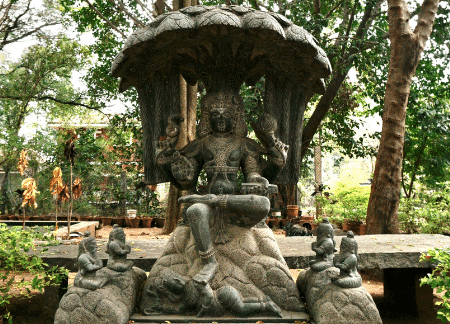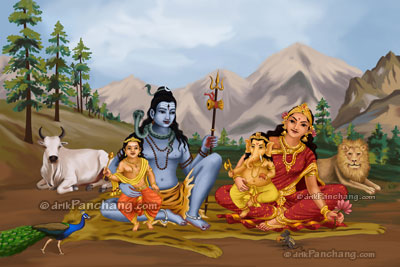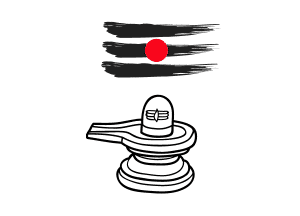
Best sanskrit words for yoga and awakening
February 10, 2023
Public Satsang or meditation in 2024 for free – your options
February 14, 2023Shiva is the most important god of Hinduism. This is also reflected when you look around India. Shiva is present in so many symbols in Indian everyday life that you have him virtually always in front of your eyes (or in your ears).
Who is Lord Shiva?
Shiva appears in many different forms. Some see him as a destroyer, others as an auspicious one. Literally translated, he means “the kind, the friendly, the auspicious one”. And he shows himself in even more ways. In this post I will give you an overview of his expressions, what meaning he has for the people of Hinduism. It is often said that he is contradictory. But which Jnani is not – especially if you want to describe and understand him with the logical mind. An impossibility.
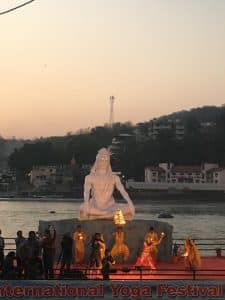
Aarti in front of Shiva in Rishikesh
The most important Hindu God Shiva
Shiva is not only one of the many deities of Hinduism. He is the source of all being, the god of gods, the absolute and only reality. The entire universe and all creatures spring from his ecstatic dance, his ecstatic meditation.
The importance of him is shown by the way he is addressed. He is the Mahayogi, he is the Mahashiva, the great Yogi, the great Shiva. From Shiva come other gods, for example Gangha, the goddess of the holy river Ganges. But not only her, also his two comrades-in-arms Brahma and Vishnu he is said to have created. Not only in one of the stories of the holy scriptures, Shiva shows his superiority to the other gods – especially Brahma and Vishnu. Once he destroys with one look a city that could not be destroyed by the other two with many weapons. And another time he settles a dispute between Brahma and Vishnu, who cannot agree on which of them is the greater, more powerful god. Shiva manifests as an infinite pillar of light, making it clear that neither of them has this role – because he is the greatest god.
Why is Shiva the destroyer?
Together with Brahma and Vishnu, Shiva forms the Trimurti in Hindu mythology, the divine trio of the creation process. He is ascribed the role of destroyer, while Brahma is responsible for the creation of the cosmos and Vishnu for its preservation.
Do you wonder why Shiva is worshipped even though he is responsible for destruction? Why is Shiva the destroyer? This has several aspects.
Destruction of the whole creation
Perhaps it is more understandable to look with a Hindu eye. In the West, we assume that creation took place many thousands of years ago. In Indian mythology, the world comes into being at every moment (the chenam) – and it also collapses again at every moment, to perish in pure consciousness. For this consciousness Shiva stands and because he also embodies this, he is responsible of the three of the Trimurti for this “destruction”. So this aspect of destruction does not describe anything destructive, but is an expression of his potential and his residence in the pure, infinite consciousness.
Destruction of the illusions of the people
Another aspect of destruction refers to Shiva destroying people’s illusions. He takes away that which keeps them from being with him, from being one with him, from being the Absolute, from being the Divine itself.
Destruction of matter with his third eye
But Shiva actually destroyed quite a bit in mythology. He does this mainly with the help of his third eye. When it is open, the ray of light that comes out of it burns everything that the ray of light falls on. How this can be and what the background is, Wolf Dieter Storl explains in his book Bom Shiva.
Shiva in the yoga tradition
If you deal with yoga, you will notice that here Shiva is not given the role of a god. Rather, he is seen as the founder of yoga. That’s why the yogis call him Adi Yogi – the first yogi. He is also called Adi Guru – the first Guru. Although he brought yoga to the world, he always made it clear that it is merely a method to make the body feel better – it does not bring you access to the all-encompassing truth, to the all-encompassing consciousness. Yoga merely helps you to have a relaxed body and thus makes it easier to realize this all-encompassing consciousness.
Shiva and Parvati – the holy family
Shiva is also the loving husband of Parvati. Together they have two sons: Ganesha and Kartikeya, who is also called Kartik, Murugan, Subrahmanya or Skanda. Often Shiva and Parvati are depicted with only one of their sons, usually Ganesha.
Who is the Indian goddess Shiva?
By people who do not know Shiva, he is often mistaken for a goddess. This is partly because of the name – but in India names meant for a man end with an “a”. In the same way, a deva is a god and not a goddess. Secondly, it is because Shiva is a woman’s name in Arabic countries. In Hinduism there is no goddess Shiva. Kali is assigned to the god Shiva and she is considered the goddess of death. In Western Slavic a goddess Siva is known.
Shiva and his symbols
The Hindu god is represented with many symbols, which also vary from region to region.
Symbolic representation of Shiva
Read here the meaning of these Hindu symbols. Sometimes there are stories around the symbols and sometimes they are simply interpreted.
Shiva in meditation posture
His skin is either black, blue or completely white with ash. He wears his long hair piled on top of his head. A crescent moon is fixed in it and a river is flowing out of it – it is the holy Ganga. Around his neck are snakes and malas made from the fruit of the Rudraksha tree. In his hands he carries his trident and a drum. He often sits on a tiger skin. Sometimes he has two arms, sometimes 4 or even 8.
Why does Shiva have a snake?
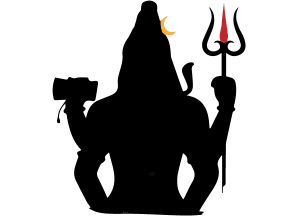
It is also said that Shiva gave protection to the snakes by letting them stay with him when it was cold on Kailash. To make them warmer, he wore them as an ornament around his body to give them warmth. Hear here of an encounter with Shiva.
In another place it is written that Shiva drank the poison of the world and the snakes would cool his neck so that he would not suffer so much because poison heats the body.
Nandi – the riding animal of Shiva
The Hindu gods all have a mount with them. Shiva rides on a bull, his name is Nandi. HWL Poonjaji says of himself that he was visited by these gods along with their mounts at night when he was in Madras (Chennai). You can read about it in his biography. They had come to him to ask for his darshan. And how it came about that Nandi became the mount of Shiva, you can find that on the page Shivadarshana.
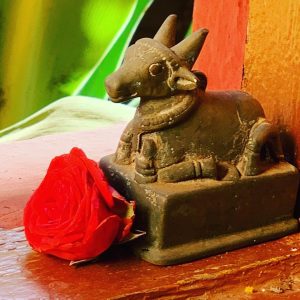
Nandi ready to be at service for Shiva
The benefactor with the deer in his hand
In the south of India, Shiva often carries a leaping deer in his hand.
God with trident or axe and hourglass drum
In the north Shiva holds a trident, in the south an axe in his hand. These are expressions of his powers as creator, sustainer and destroyer of the universe and are said to symbolize impermanence. Likewise, the hourglass drum is a symbol of impermanence and that Shiva resides beyond time.
Half Moon
The half moon in India looks like a bowl. And in this lying orientation, Shiva carries the half moon in his hair. When the moon is in this position, it is also called the Shiva moon.
Tiger skin
Shiva sometimes sits on the tiger skin and sometimes he has it wrapped around him as clothing. This indicates that he has overcome his animal nature. Sometimes it is also interpreted that this Jnani is so strong that he can even tame the tigers, overcome the tiger. It is a symbol of his strength and power.
Conch
Shiva is not depicted with the conch – this is blown by the worshippers like a horn. With this sound he is called and worshipped.
What is a Shiva eye?
There is also the eye of Shiva. This is the closure of a sea snail that can be found in the sand. It bears a spiral pattern and is popular as a piece of jewelry.
Where can you find Shiva eyes?
I found my Shiva eyes on the beach in the Andaman Islands. Unfortunately, I do not know where else they are usually found.
Om Shiva
In pictures, Shiva often carries an Om symbol in his open palm. If he is depicted as a lingam or as a dancing Nataraj, the wreath of flame around the base symbolizes the sacred syllable Om. This is said to be the sound on which the universe is built. It is clear that Shiva is depicted with it, if he is supposed to be responsible for creation, but also for destruction, isn’t it?
Rudraksha
The wizened fruits of the granite tree are also called tears of Rudra. Threaded on as a prayer garland, they are called Mala in India. They also symbolize the demon heads cut off and shriveled by Durga and are worn by the sadhus. Some also see in the Rudraksha beads the tears of Shiva, which he shed when he perceived the suffering of the world.
The cosmic dancer Nataraj
Tandav is the name of his divine dance of rage and death, which he dances when the universe must come to an end. But first of all, Shiva dances his joyful dance of ecstasy. And this dance is said to sustain the universe. Everyone is probably familiar with the depiction of Shiva dancing, surrounded by a circle of flames, on top of a demon.
What is a Shiva Lingam?
Shiva resides beyond name, form and time. Especially in the holy scriptures it is emphasized again and again that he is formless. To convey this figuratively, he is often depicted not with human features, but symbolically as a Shiva Lingam. To the Shiva Lingam belongs a Yoni, from which a phallic symbol emerges. Together they symbolize the potential creative power. When the lingam rests in the yoni, peace, harmony and happiness prevail in the world. In front of the lingam very often still sits Nandi, his mount. Ready, when he manifests, to be at his service.
Sometimes it is also represented as a conical stone. These conical stones are used in various sizes. As a healing stone they are often the size of a thumb. Sri HWL Poonja describes in his biography (Nothing ever Happened) that he placed such a conical stone in Hawaii in a cave.
What does the mark on Shiva’s forehead mean?
Three lines on his forehead are the sign of the Brahmins. Often his closed third eye is still depicted. The strokes are painted with sacred ash (vibhuti). It serves as a protection against unholy people and as a sign that only ashes remain who will be consumed by the fire of devotion to be Shiva himself. Some paint the three strokes not only on the forehead, but also on the forearms, upper arms and on the throat. The lingas made of stone also bear the three strokes. When all illusions are burned, all doubts are cleared, there is the knowledge that one is Shiva himself.
Some of the names of Shiva
It is said that Shiva is known by 1008 names. I will not collect all of them here, but I will put together the most important ones for you:
- Mahadeva – the great god, the god of gods
- Mahakal – god of time
- Bairava – the terrible one
- Gaura – the radiant one, the white one
- Vishvanatha – Lord of the Universe
- Shankara – the beneficent, the peaceful one
- Nataraj – the ecstatic dancer
- Pasupathinath or Pashupati – Lord of all living beings, Lord of all creatures and Lord of all animals.
- Harshana – the god of celebrations of the dead
- Aushadhishvara – lord of herbs, plants and intoxicating drugs
- Ganghadara – ghan carrier
- Narayana – God in human form, has seen through his illusion and no longer clings to it.
- Mrityumjaya – vanquisher of death
- Ardhanishvara – the god who is male and female at the same time
- Satchitanand – the embodiment of truth, wisdom and bliss.
- Nilakantha – the blue-necked one
How is Shiva worshipped?
While it’s the greatest worship also for Shiva is to abide in him, there are many more forms of worship the highest deity.
Mantras in honor of Shiva
Shiva Shambo
Om Nama Shivaya
Arunachala Shiva – invocation of the potential life energy.
So’ham, Shivo’ham – I am he, I am Shiva
Shivaji
No devotee of Shiva would call him “Shiva.” His name is always followed by -ji, as a sign of reverence.
Invocations, poems, prayers
Instead of chanting, poems are also written and recited. Like these “waves of bliss” dedicated to Shiva.
Shivaratri – the festival in honor of Shiva
What is Shivaratri? It is said that Shiva spends mostly in meditation. However, not on Shivaratri night, he is awake and hears all the prayers addressed to him. What is an opportunity for Shiva to emerge from his meditative immersion, is an opportunity for the devotees and disciples to immerse themselves in it. Because basically, it’s not about Shiva fulfilling worldly desires. He can help you experience and dwell in pure consciousness. And that is supposed to be easier on Shivaratri than on other days.
Maha Shivaratri – the great night of Shiva
While in India Sivaratri is celebrated every month, there is Maha Shivaratri only once a year. This is “the great night of Shiva.” It is his wedding night and the highest holiday in the Hindu calendar. There is no night when Shiva can be found in a better mood. Everyone who is anyone makes a pilgrimage to a Shiva Lingam. Shiva pujas are held there and pilgrims fast and keep vigil all night. They bring flowers and fruits, listen to music and dance ecstatically. Since the holy Arunachala is considered to be such a lingam, many Indians go on pilgrimage to this place and most of them go around the mountain in a Pradakshina on this Maha Shivaratri night. Miracles of all kinds are said to happen on this night.
Shivaratri 2023
In the year 2023 Maha Shivaratri takes place on February 18th. In 2024, March 8 will be Maha Shivaratri.
Shiva’s Women
The woman with whom Shiva is often associated is Parvati.
- Parvati – the daughter of the mountains, gentle, patient mother and wife.
- Uma – goddess of light and beauty, goddess of the whole world
- Sati – virtuous woman, goddess of longevity and marital happiness
- Shakti – the unmanifested feminine power
- Durga – the elusive one, the goddess of perfection
- Kali – the black one – goddess of death, destruction and new beginnings
- Gauri, Gangaur – woman who belongs to the white Shiva, who is called Gaura. She is the goddess of abundance.
Where is the abode of Shiva?
Shiva, of course, is found all over India and is at home there. But in some places he is especially worshipped. There are cities – but also mountains and temples.
The holy cities of Shiva
There are a total of 12 Shiva temples in India, known as Jyotirlinga.
Kashi is the city that Shiva never leaves – his favorite place. It is the ancient name of Varanasi, the Indian city where every Hindu practitioner wants to die. It is located in the north of India. For it is guaranteed to merge into Shiva – that is, to find enlightenment, to enter formlessness – for the one who dies in this city.
In Tiruvannamalai, in the south of India, there is a Shiva temple, and the city is at the feet of the holy Arunachala, which is said to be a manifestation of Shiva.
The Sacred Mountains of Shiva
Shiva is the “Lord of the Mountains.” Two of them claim to be his abode, even his manifestation.
Kailash in the Himalayas
Kailash is often called the residence of Shiva. It does not mean that he “resides” there in the Himalayas, it means that the mountain itself is an expression of Shiva and his presence is felt there. Many people know that Shiva is associated with the holy mountain Kailash. He is said to sit there constantly absorbed in meditation.
Arunachala in Tamil Nadu, South India.
There is another mountain that is considered to have even greater significance: The sacred mountain Arunachala in the southern state of Tamil Nadu in Tiruvannamalai. This mountain is circambulated by many pilgrims on a daily pradakshina in honor of Shiva. Sri Ramana Maharshi speaks of this mountain as his guru and also says that Arunachala is a manifestation of Shiva. Also David Godman writes about the power of Arunachala on his website. For the festival of lights in autumn (Diwali), large amounts of ghee are carried to the top. At the top, the ghee is lit and it is symbolic of this pillar of light as a great fire and visible from afar.
Arunachala, You extinguish the ego of those who meditate on You in their hearts.
The Marital Garland of Letters – stanza 1 – by Bhagavan Sri Ramana Maharshi.
Even words of Shiva about the Arunachala are said to have been handed down:
“What cannot be attained without great effort – the true meaning of Vedanta (Self-realization) – can be attained by anyone who looks at this hill from where it is visible, or even thinks of it mentally from a distance.”
Arunachala Mahatmyam (Skanda Purana)
If you don’t know the Arunachala, you can take a look at it in the livecam.
Hemp – the sacred plant of Shiva
What is hardly written anywhere – Shiva is also the patron saint of hemp.
Does Lord Shiva smoke chillum and drink Shiva Bang?
It is undisputed that Shiva is the Lord of Mariuhuana, of Hemp. This is often suppressed in other accounts of the great god. Some say, “Shiva would never do that.” – the others are sure that Shiva smokes a joint now and then.
Bangh is a hemp-infused drink consumed during religious festivals (holidays or celebrations of the dead) or poured over the Shiva Lingam out of devotion to Shiva during a puja.
In his book Bom Shiva, Wolf Dieter Storl writes an explanation that seems conclusive:
The plant is a sacrament, which – in the correct ritual context and with an unbiased mind – enables communion with this “god of gods”. It leads to the depths, to heaven. It connects, the Hindus say, with Shiva, who is at the same time our most own, true self.
So it’s not about drug abuse, it’s about using the herb spiritually to experience the true self. It clears the way to eternity. Of course, it is not meant to distract from or escape from the tasks of everyday life.
In the 60s and 70s of the 20th century … flowers … children went on pilgrimage (to India), … joined … sadhus, shared with them the ganja smoking pipe (chilam) and listened to never before heard words of eternal wisdom. Under the instruction of the sadhus, they elicited from the chilam dimensions quite different from those of the joint, which was puffed without spiritual reference. The marijuana joint… could only take away a little from the … nightmare its hard edges and sharp corners… The chillam, however, was a gateway to Shiva!
… the Shaivas, the devotees of Shiva let us know, only a soul, which is pure and strengthened by dharmic way of life and by yoga, can help Siva’s herb to enlightenment.
My personal experience is that it does not need the herb and I have no personal experience with it. However, I appreciate Wolf Dieter Storl’s statements very much and so I added this aspect – simply because it belongs to Shiva.
Reasons why Shiva is the most important god in Hinduism.
Top reasons why Shiva is the most important god in Hinduism: Shiva is the most important god in Hinduism because he is considered the sole ruler of knowledge, fertility, joy and well-being. He is the creator of the world as well as the divine warrior who defeats evil and brings purity to the world.
These are the top 20 reasons why Shiva is the most important god in Hinduism.
- He is the god of completion.
- Shiva is often known as “Ashutosh,” which means “King of Patience.”
- He is the only god who can help creation to completion.
- He is the god of rebirth.
- He is the only god who can transplant souls into new bodies.
- He ends the circling of death and rebirth.
- By worshipping Shiva, individual souls can be liberated from the cycle of death and rebirth.
- He makes liberation possible.
- He is the ruler over karma.
- Shiva is the ruler over karma as we reap it in our lives.
- He gives us the power and the ability to deal with the consequences of our actions.
- He gives the benevolence and forgiveness.
- He is the god of progress.
- Shiva, as the most important god in Hinduism, ensures that we can integrate the non-violent energy of progress, knowledge and wisdom into our daily lives.
- He helps us to use the potential of progressiveness for the benefit of humanity.
- He is the god of meditation.
- Shiva has brought yoga to the world.
- He also helps the animals and is their patron.
- He fulfills all the wishes of his devotees.
- He is a god in human form.
Hi, I am Shivani
Blogger and podcaster at Madhukar Enlighten Life. I have known Madhukar since 2004 and am doing what I can to help this important message of happiness reach as many people as possible.
What is your experience with Shiva? Can you feel his power within you? Or do you feel like tasting how it’s like to abide in him? (Then get the free guided meditation which will lead you there.) Tell me in the comments.
* If no popup opens when you go to the Home of the website, then most probably you have been here already, clicking the popup away. Then you have to empty your cache.

